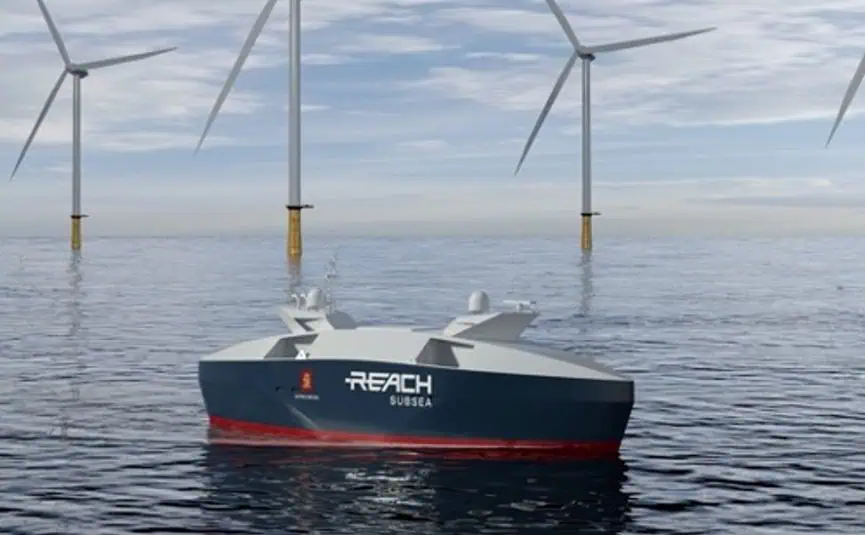Future proofing subsea services through remote and autonomous operations. For the past 18 months, Reach Subsea ASA (Reach) has been developing new and future-proof, sustainable solutions for subsea services.
The project, named Reach Remote, is carried out in cooperation with renowned industrial partners Kongsberg Maritime and Massterly, and is also supported by a grant from Innovation Norway.
The first stage of Reach Remote is to introduce Unmanned Surface Vehicles (USVs) dedicated to survey, inspection, and light repair projects. These USVs will serve as mobile power banks, data centres and communication modules for underwater ROVs (Remotely Operated Vehicles), with both the USVs and ROVs operated from an onshore control centre. Features for both real time operator control and autonomous operations will be incorporated, as well as hybrid modes blending remote and semi-autonomous control. The goal is to be in the market with the first two USVs in 2022, with the ambition of providing a full portfolio of subsea services from a low-emission, cost-effective remote and autonomous fleet by 2025.
The low-emission, cost-effective subsea services which will be offered by Reach Remote are viewed with great interest from both offshore wind farm operators and oil and gas asset owners. Reach Remote will be a great enabler, building on framework agreements already in place to position Reach as a preferred supplier of survey, inspection, and light repair services to the fast-growing offshore wind industry. It will also be key to providing services to other markets, such as aquaculture, subsea mining, and environmental surveillance.
Technology is enabling a radical redesign of how ROV operations are performed: shifting from a capital- and personnel-intensive setup operated from larger, energy-intensive offshore vessels towards a lean remote and autonomous platform, with certified personnel located onshore. Reach Subsea’s operational competence – together with Kongsberg Maritime’s advanced technologies and Massterly’s pioneering efforts in autonomous maritime operations – is vital to unlocking this opportunity.
Currently, Reach provides its subsea services from six vessels. A typical Reach project today will involve some 30-50 personnel onboard a subsea vessel operating under strict HSEQ regimes. With Reach Remote, the same project can be executed with a much smaller, more fuel-efficient vessel and one third of the personnel, who will be located onshore without exposure to offshore operational risks. This is revolutionary in terms of cost efficiency and enhanced safety and will drastically reduce the CO2 footprint of this type of operation.
The key benefits of Reach Remote, compared to equivalent solutions using a full-scale subsea vessel, are:
- More than 90% reduction in CO2 and NOx emissions
- Virtual elimination of the personnel risk associated with offshore operations
- Significant reductions in the cost of subsea survey and inspection services
Financing of the construction part of Reach Remote is being evaluated and may involve new equity, new debt, industrial partnerships, or a combination thereof.
Tom Eystø, CEO of Massterly – a Kongsberg Wilhelmsen joint venture – says: “The Reach Remote concept fits perfectly with Massterly’s offering of safe, cost-effective and environmentally friendly logistics solutions. We are proud to be preferred partners for Reach Subsea for the operation of their USVs. The unmanned vessels will be operated from our Remote Operations Centre, manned with certified maritime personnel. The Remote Operations Centre will also serve other innovative customers like ASKO, who has two autonomous vessels under construction for delivery in 2022. By uniting the competencies from Massterly’s two owners, Kongsberg Maritime and Wilhelmsen, we are in a unique position to deliver future-proof services to Reach Subsea.”
Jostein Alendal, CEO of Reach Subseas, says: “Based on the massive feedback and interest we experience from our clients, we believe the timing is right to introduce Reach Remote to the market. Even though the transition from manned to unmanned needs some time it is realistic to aim for a fleet of at least 10 USVs as early as 2025 in our worldwide operations. There is no doubt in my mind that we have joined with the right partners to drive the development and be in the forefront of this transition. Unmanned and carbon neutral offshore operations is a bold ambition, but with right team and the right partners we believe this ambition is achievable.”
Reach Remote main design features
The Reach Remote project uses a USV in conjunction with a next-generation ROV in an innovative solution which will transform the current market for ROV survey and inspection services. The Reach Remote USV design philosophy is based on a few key drivers which are instrumental in the total solution. The main design features are:
- Dedicated unmanned, self-propelled remotely and autonomously operated ROV mother vessel of approx. 25 m overall length.
- Robust maritime and subsea equipment with high reliability and long maintenance intervals
- Onshore control room facilities for both marine and ROV operations
- Semi-autonomous ROV for survey and inspection tasks
- Hull-mounted survey sensors
- Optimised hydrodynamic properties for excellent data acquisition and subsea positioning performance
- Focused on ROV operability in an extended weather window vs. peers
The USV solution has been optimised for very low energy consumption and a minimal carbon footprint. The current design is based on a redundant hybrid electric configuration and will be capable of 30 days or more endurance for most operations, ensuring efficiency and operational flexibility.













